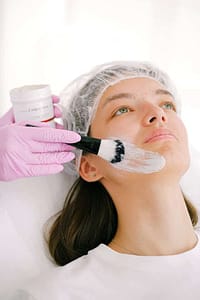Understanding Skin Changes
As you navigate through the transformative phase of menopause, you may notice a range of changes in your skin. Understanding these changes is the first step towards managing them effectively.
Impact of Hormone Decline
The decline in hormone production, particularly the dip in estrogen levels known as hypoestrogenism, is a hallmark of menopause. Estrogen receptors are abundant in various areas of the body, including the genital area, face, and lower limbs. These areas are particularly sensitive to the reduced estrogen levels experienced during menopause, which can lead to specific skin conditions that are more prevalent in peri- and post-menopausal women compared to other age groups (DermNet NZ).
With the decrease in estrogen, you may observe your skin becoming thinner, less elastic, and drier. This is because estrogen is intricately linked to processes such as collagen production and wound healing within the skin. Post-menopausal women often experience diminished collagen levels, which can contribute to wrinkles and a thinning skin texture. Hormone replacement therapy has been observed to bolster collagen levels in the skin, potentially mitigating some of these effects.
Common Skin Conditions
During this transitional period, you may encounter a variety of skin issues. These can range from hirsutism (the growth of excess hair on the face) to acne, skin thinning, a slowdown in skin renewal, increased dryness, heightened sensitivity, sagging, and the development of wrinkles. Flushing and redness can also occur due to the hormonal shifts that are part and parcel of menopause (Turner Dermatology).
To address these skin changes, menopause-specific skin care products can play a supportive role. They can help to combat dryness, fortify the skin’s natural barrier, minimize breakouts, and refine skin texture. When selecting these products, look for key ingredients such as ceramides, chemical exfoliants, antioxidants, and estrogen receptor modulators, which are all beneficial for tackling menopausal skin concerns (Turner Dermatology).
As you manage these changes, it’s important to consider the broader context of skin health during significant life stages. Exploring topics such as skin changes during pregnancy, skin changes during perimenopause, and skin changes after childbirth can provide you with a comprehensive understanding of how hormonal fluctuations influence your skin. Additionally, addressing skin changes and stress, skin changes and nutrition, and skin changes and hydration will equip you with the knowledge to maintain your skin’s health and radiance during menopause.
Effects on Skin Health
During the transition into menopause, your skin may undergo several noticeable changes. The decline in hormones, particularly estrogen, can lead to various effects on skin health, including thinning and dryness, hair changes, and loss of collagen.
Thinning and Dryness
As estrogen levels decline during menopause, your skin may become thinner and more prone to dryness. Estrogen plays a key role in maintaining the barrier function of the skin and in retaining moisture. With lower levels of this hormone, you might notice that your skin feels drier and is more sensitive to irritants. Thinning skin also tends to be more vulnerable to environmental damage.
To combat these changes, it’s important to adopt a skincare routine that focuses on hydration. Look for products that contain hyaluronic acid or glycerin, which are excellent for drawing moisture into the skin. Additionally, using gentle, non-soap cleansers and applying moisturizers immediately after bathing can help lock in moisture. For more information on maintaining hydration, visit skin changes and hydration.
Hair Changes
Menopause can also lead to changes in hair patterns. You might experience thinning hair on your scalp or develop unwanted facial hair. These changes are due to the hormonal imbalances that occur during this stage of life, particularly the relative increase in androgens compared to estrogen.
Managing these hair changes often requires a multi-pronged approach, including topical treatments, hair care adjustments, and in some cases, medical interventions such as hormone therapy. Discover more about managing hormonal effects on your hair by exploring hormonal skin changes.
Collagen Loss
Collagen is a protein that provides structure and elasticity to your skin. During the first five years of menopause, collagen levels can drop by approximately 30%, leading to thinner, less elastic skin that is more prone to fine lines and wrinkles. This is followed by an average decrease of 2% per year over the next two decades.
To address collagen loss, consider products that boast ingredients known to stimulate collagen production, such as retinoids and peptides. Treatments such as laser therapy and micro-needling may also promote collagen synthesis. The use of hormone replacement therapy has been shown to increase collagen levels in the skin, which can help reduce the appearance of wrinkles.
The table below summarizes the percentage of collagen loss during and after menopause:
| Timeframe | Collagen Loss |
|---|---|
| First 5 years of menopause | 30% |
| Each subsequent year | 2% |
Understanding and managing these skin changes can help you maintain healthier skin throughout menopause. While some effects are a natural part of aging, there are effective strategies and treatments available to help you sustain your skin’s health and appearance. Explore various treatment options, and consider consulting a dermatologist for personalized advice. For further reading on skin changes at different life stages, check out skin changes during perimenopause and skin changes after childbirth.
Managing Skin Changes

Navigating through the landscape of skin changes during menopause requires a multifaceted approach. Your regimen should include diligent moisturizing strategies, exploring various treatment options, and adopting supportive lifestyle factors. Let’s delve into these areas to help you maintain your skin’s health and radiance during this transformative time.
Moisturizing Strategies
With decreased oil gland activity after menopause, your skin may become drier. To combat this, employ moisturizing strategies that give your skin the extra care it needs. Opt for a richer, heavier cream to lock in moisture. It’s also wise to shy away from long, hot showers that can strip your skin of its natural oils. Applying your moisturizer while your skin is still damp can enhance hydration efficacy WebMD.
Additionally, given that your skin may lose some of its water-retaining ability, consider products that contain hyaluronic acid or glycerin. These ingredients are known for their capacity to attract and hold moisture. Switch to mild cleansers that don’t compromise your skin’s natural barrier and consult a dermatologist before incorporating exfoliation or microdermabrasion into your routine, especially if your skin is particularly sensitive during this period American Academy of Dermatology.
Treatment Options
The loss of collagen during menopause can lead to visible signs of aging, such as sagging skin, the formation of jowls, wrinkles, and enlarged pores. To address these concerns, sun protection is paramount to prevent further skin damage. Products containing retinol or peptides may also help stimulate collagen production and improve skin texture.
For those experiencing a significant loss in skin elasticity and firmness, hormone replacement therapy (HRT) may be an option to discuss with your healthcare provider. Additionally, treatments like BOTOX can be considered to reduce the appearance of fine lines and wrinkles Healthline.
Lifestyle Factors
Your lifestyle has a profound impact on your skin’s health. Regular exercise not only benefits your overall well-being but also enhances skin function. Engaging in physical activities increases blood flow to the skin, stimulates hormone production, and can help alleviate symptoms such as hot flashes. However, it’s important to be mindful of your exercise environment to avoid potential adverse effects on the skin, like eczema from chlorinated water NCBI.
For more information on how to take care of your skin during other life stages, explore our resources on skin changes during pregnancy, perimenopause, puberty, after childbirth, menstruation, as well as the effects of stress, nutrition, and hydration on your skin.

